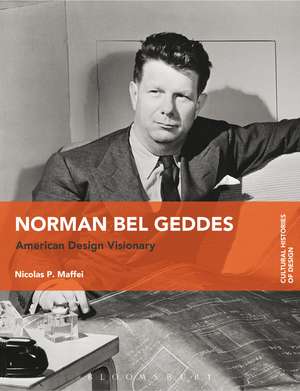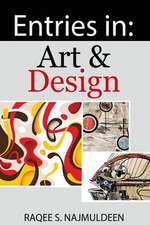Norman Bel Geddes: American Design Visionary: Cultural Histories of Design
Autor Nicolas P. Maffeien Limba Engleză Paperback – 21 feb 2018
Preț: 183.54 lei
Preț vechi: 225.06 lei
-18% Nou
Puncte Express: 275
Preț estimativ în valută:
35.12€ • 38.14$ • 29.50£
35.12€ • 38.14$ • 29.50£
Carte disponibilă
Livrare economică 02-16 aprilie
Preluare comenzi: 021 569.72.76
Specificații
ISBN-13: 9781474284615
ISBN-10: 1474284612
Pagini: 256
Ilustrații: 150 BW illus
Dimensiuni: 189 x 246 x 18 mm
Greutate: 0.59 kg
Editura: Bloomsbury Publishing
Colecția Bloomsbury Academic
Seria Cultural Histories of Design
Locul publicării:London, United Kingdom
ISBN-10: 1474284612
Pagini: 256
Ilustrații: 150 BW illus
Dimensiuni: 189 x 246 x 18 mm
Greutate: 0.59 kg
Editura: Bloomsbury Publishing
Colecția Bloomsbury Academic
Seria Cultural Histories of Design
Locul publicării:London, United Kingdom
Caracteristici
Features fascinating source material from the Norman Bel Geddes Archive at the Harry Ransom Center (HRC), at the University of Texas, Austin.
Notă biografică
Nicolas P. Maffei is Senior Lecturer in Contextual Studies in the School of Design, Norwich University of the Arts, UK. He has published widely on American design, streamlining, art deco and modernism.
Cuprins
Introduction1. Becoming a Practical Visionary: Geddes's Youth and Early Career- Portraiture and Advertising Illustration- Christian Science and Fordism- InWhich Magazine2. Transforming Audiences: Stage Design to Industrial Design- Geddes's Knowledge of Theosophy, Psychology, and Advertising- Theater Number 6: Merging the Audience and Actors- Geddes's Stage Design Course, 1922-1928- Franklin Simon Window Displays, 1927-1930- J. Walter Thompson Assembly Hall, 1929- From Stage Design to Architecture: Plans for the Chicago World's Fair, 1933- The Therapeutics of Color in Interior Design, c. 1930- Design Proposal for the Kharkov Theater, Ukraine, 1931- Architecture as a Lively Art 3. Horizons: Publicizing the Visionary Designer- Promoting the Artist in Industry- The Aerial Restaurant, Air Liner Number 4, and the Standard Gas Equipment Stove - Horizons and Towards a New Architecture- Influences of Technocracy and Scientific Management - Horizons' Press Reception- Technological Forecasting in Horizons 4. A Machine-Age Architecturalist: Planning the Factory, Service Station, and the Mass-Produced Home- Toledo Scale Factory- The House of Tomorrow, 1931- A Modern, Mass-Produced Service Station: Socony-Vacuum, 1934- Hopes for the Factory-built House: 1939-1945- Geddes Seeks an Architectural License 5. Streamlining: From Imagined Ideal to Commercial Reality- Graham-Paige Motor Cars, c. 1928-1933- Horizons and Ideal Streamlining: Car Number 8 and Pan American Airways - Critics of Streamlining - Chrysler Job: Publicizing and Designing the Ideal Car, 1934- Geddes Designs for Chrysler - Ideal Streamlining and the Rear-Engine Debate- Publicizing Streamlined Design- Cleanlining and Novel Uses of Streamlining, c. 1932-19506. Consumer Research: Imagining the Ideal Consumer, Developing a Popular, ModernAesthetic - Early Consumer Surveys: Philco and Abeyton Realty - 'Tomorrow's Consumer,' 1943- Designing for the Postwar Consumer: Shell Oil, Radio Corporation of America, and Rittenhouse Chimes7. The Production and Consumption of Model Worlds: Futurama and 'War Maneuver Models' Exhibition, 1937-1944- Miniature Games: The Origins of Geddes's Modelling and Futurology. - Shell Oil 'City of Tomorrow' Advertisement, 1937 - The General Motors Futurama Exhibit, New York World's Fair 1939-1940- Futurama - Planning and Research: Creating a Theatrical Simulation- Constructing the Future: The Publicity and the Press- Futurama as an Advertisement- War Models in Life Magazine, 1942, and at The Museum of Modern Art, New York, 1944 - ConclusionReferencesIndex
Recenzii
Maffei's impressive, revealing biography grounds Bel Geddes's contributions to graphic arts, theater, product design, urbanism, and social engineering in undercurrents of mystical theosophy, positive thinking, socialism, evolutionism, and utopian science fiction-yielding a popular therapeutic modernism for the consumer age.
Maffei's impressive portrait of industrial designer, Norman Bel Geddes, shows us how this 'practical visionary' envisaged a thoroughgoing re-design of the modern material environment, transforming as he did the appearance of stage sets, automobiles, airplanes, exhibitions, architectural structures and brand identities.
Maffei is one of a new generation of design historians bringing new research and fresh insights to the table. His original and insightful archival research underpins his valuable contribution to our deeper understanding of Bel Geddes' work and thought.
Nic Maffei's in-depth cultural biography of Norman Bel Geddes casts the designer as a 'pragmatic visionary'. Grounded in painstaking archival research and a wide historical context, this important study traces the designer's path from early avant-garde theatre design in Europe to leading industrial designer who shaped the face of modern America. It promises to become a standard reference for this key figure in design history.
Maffei's impressive portrait of industrial designer, Norman Bel Geddes, shows us how this 'practical visionary' envisaged a thoroughgoing re-design of the modern material environment, transforming as he did the appearance of stage sets, automobiles, airplanes, exhibitions, architectural structures and brand identities.
Maffei is one of a new generation of design historians bringing new research and fresh insights to the table. His original and insightful archival research underpins his valuable contribution to our deeper understanding of Bel Geddes' work and thought.
Nic Maffei's in-depth cultural biography of Norman Bel Geddes casts the designer as a 'pragmatic visionary'. Grounded in painstaking archival research and a wide historical context, this important study traces the designer's path from early avant-garde theatre design in Europe to leading industrial designer who shaped the face of modern America. It promises to become a standard reference for this key figure in design history.























